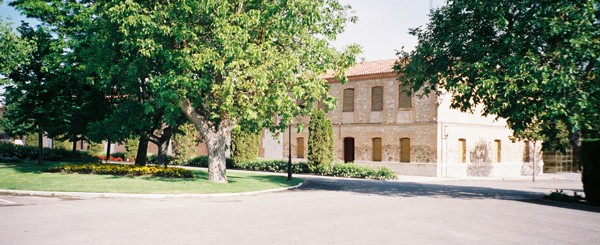
Vega Sicilia: Myth and Reality
Some estates have an aura about them: they produce the greatest and most sought-after wines, often wines of legend. Sometimes the legend is created by clever marketing departments, sometimes by stratospheric pricing, sometimes by 100 point scores from influential critics. Sometimes the wines they produce are such exquisite expressions of the winemaker’s art and science that they can achieve this legendary status without the need of marketing departments and critics. Sometimes it’s a bit of each.
One such estate is Spain’s Vega Sicilia. My first experience of the wines of Vega Sicilia were when Bibendum substituted a couple of bottles of Valbuena for the Quintarelli Amarone I had ordered, and since then I have had the opportunity to taste or drink Vega Sicilia’s wines on just a couple of occasions. They were impressive, to say the least, and when the opportunity to visit the winery in Valbuena de Duero, I moved quickly.
Vega Sicilia likes to think of itself and its wines as a myth and a legend: the words recur in their publicity materials. For a myth, there’s a surprising amount that’s well recorded both about the history of Vega Sicilia and the winery. The myth and legend comes, in my view, from its market positioning as an exclusive wine, which in itself comes from the low yields and meticulous wine-making. The wines age extremely well and the longevity of some older vintages and their quite natural limited availability today adds to the myth.
The history
The history of the estate as it now exists goes back to 1848 when a Basque landowner, Don Toribio Lecanda, met the bankrupt Marques de Valbuena and bought off him a 2,000 hectare estate, the Pago de la Vega Santa Cecilia y Carrascal. Somehow and at some stage that got shortened to Vega Sicilia.
For the first 16 years, the land continued to be used for agriculture. Then in 1864 Toribio’s son, Don Eloy Lecanda y Chaves, who had inherited the property in 1859, founded the winery. From one Monsieur Beguerié in Bordeaux he bought 18,000 young vines of Cabernet Sauvignon, Carmenere, Malbec, Merlot and Pinot Noir. They may have made some wine at that stage, but most of the production went into brandy and ratafia.
In due course Don Eloy went bust and the estate passed to the Herrero family. They employed another Basque, Domingo Garramiola Txomin, who had trained as a winemaker at the Haro Oenological Centre.
At first most of the wine was sold in bulk and – presumably – passed off as Rioja. When the Rioja vineyards had recovered from phylloxera in 1915, however, Garramiola turned to making bottled wine, which was initially not made available commercially, but instead given away by the Herrero family to friends and acquaintances in the upper classes and the aristocracy. Not exactly hugely good business sense, but this could well be one of the bases of the myth of Spain’s most expensive and sought after wine. It was the 1917 and 1918 wines made by Garramiola that won prizes at the World Fair in Barcelona in 1929, still celebrated on bottles of Unico.
1982 saw the next significant changes. On the one hand, the Denominacion de Origen Ribera del Duero was established, which meant that Unico (and the other wines) were no longer "simple" vino da mesa table wines. On the other, the Alvarez family bought Vega Sicilia and began a modernisation process and expansion that has continued with the creation of Bodegas Alion in 1992 and Bodegas Alquiriz (in Toro) in 2001, as well as Tokaj Oremus, founded in 1993.
Besides Alion, the Toro wines from Alquiriz (now released under the Pintias label) and Oremus, there are three key wines in the Vega Sicilia portfolio, and it is these that carry the Vega Sicilia name:
The estate covers around 1000 hectares, of which 230 - 250 are under vines. The best vineyards are on north facing slopes, while others are on the alluvial deposits in the valley: in all there are 19 different soil types. The bulk of the vines are now tempranillo (here called tinto fino or tinto pais), with some cabernet sauvignon, malbec, merlot, carmenere and a small amount of albillo (a local white grape).
The visit
We had our appointment. It had been agreed that we would have a tour of the winery facilities and a short tasting. Shortly before the appointed time on the morning of the 28th May 2003, we arrive at the gates of Vega Sicilia. There is nothing happening, and nobody around, just the rhythmic sound of the sprinklers watering the gardens. The heart sinks. We’ve heard all the stories about famous Masters of Wine and similar luminaries being turned away with or without appointment.
We realise we’re at the wrong gate. Phew!
We drive on a short distance and turn back up a short drive to where a ‘sentry’ smokes a cigarette and guards the barrier. There is an exchange in grumpy unintelligible Spanish between our driver and the guard. Some papers are exchanged. Subconsciously, we reach for our passports. Eventually, the barrier is raised and we are directed to park just by the first gate that we had tried. Somebody would be with us shortly.
Five minutes pass. We admire the well tended gardens and pristine property. We check our watches. We wander around, but only in a small area, lest further guards appear and shoot us for border infringements. The sprinklers continue to tick tick tick. Ten minutes pass. Our watches continue to tick tick tick. I catch sight of a small, slightly impish face which appears out of a doorway of the main building. Excellent. The waiting’s over. The face, and its owner’s body disappears. We wait. The sprinklers continue. Time passes. Well, at least there are worse places to spend a morning. Still not wanting to stray too far I look around. The main building, vaguely familiar from the Valbuena label (though in reality in much better repair) lies before us, built of an attractive yellow brick and stone. It has a certain air of the religious about it, with its central pediment surmounted by a cross. Unfortunately, my photograph has a tree in the way.

Vega Sicilia’s front garden and main building
To one side there are signs of more obviously working buildings with some empty palettes in the sun. Just behind is an impressive chateau building
(see photo, right).
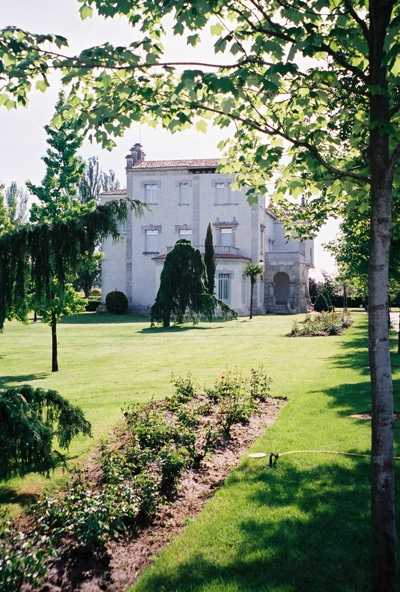
More time passes. It is a fine sunny day, the wind is light, it’s not too hot and it is nice to have a bit of a rest. Oh, no hang on. We’re due at Abadia Retuerta in time for lunch. Oh, well, nothing we can do about it. The sense of anticipation regarding this visit had been great since leaving Gatwick. Now it was getting unbearable.
Some more time passes. We know the tarmac on the car park quite well by now.
Eventually, the same slightly impish face reappears, and this time it has a body, and it’s walking towards us. It belongs to Rafael Alonso, Vega Sicilia’s Export Manager.
After the usual pleasantries Rafael leads us into the buildings explaining the Vega Sicilia product range, philosophy etc.
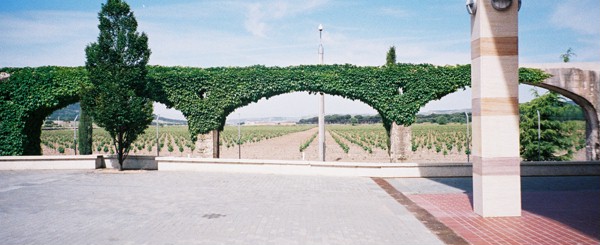
Beyond the bottle store (on the right) can be seen the vineyards on the alluvial plain.
In the vineyards, yields are kept low by green harvesting to under 22 hl per hectare, with each vine being limited to producing less than 2 kg of grapes. New vines are not bought in, but rather they use their own vines, grafting cuttings onto new rootstocks.
Harvest is always late - 1st October at the earliest (2003 is the exception, when they started mid September!) - and by hand. They employ a team of around 130 harvesters who pick in several passes through the vineyards. The grapes are brought in plastic crates holding about 20kg each. There is another rigorous selection at this stage, and the grapes are carefully de-stemmed. In general the different varieties are fermented separately, with grapes destined for Valbuena being fermented in stainless steel and those for Unico in oak vats, and it seems that they have been playing around with fermentation from different plots, some in stainless steel, some in wood, some in concrete. They weren’t forthcoming about the results of these experiments.
The low yields and careful selection keeps production low, helping to maintain the myth of Vega Sicilia. Annual production is around 25,000 cases and they currently have about 2000 people on a waiting list for an allocation. Around 50-60% of production goes to the domestic market and the rest to around 50 export markets. Interestingly, buyers are not required to take Alion or Oremus in order to get hold of Vega Sicilia proper.
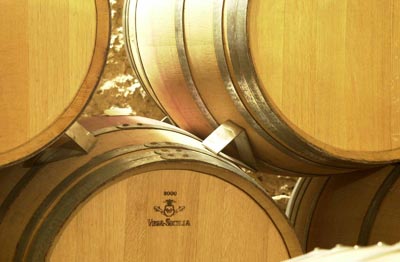 |
Two immediate things strike you as you walk round the Vega Sicilia winery. There is a lot of money floating around the place: everything is in perfect order, there are fancy designer light fittings on the wall and it’s clean. That’s the second thing that strikes you. This place is clean - absolutely pristine and spotless, to the point of obsessiveness. Perhaps this goes back to the time the 1994 Valbuena was recalled, it is said because of a cork problem. Certainly, now everything is done to avoid any possibility of taint from any source. Metal is stainless steel throughout, down to the bands on the barrels and the wedges
(see
left, photo from vega-sicilia.com) on which the barrels rest. Even the palettes used for shipping are stainless steel. The wood used for cases is tested to ensure it is chemically inert. No wine is shipped between June and October, unless temperature controlled lorries are used.
|
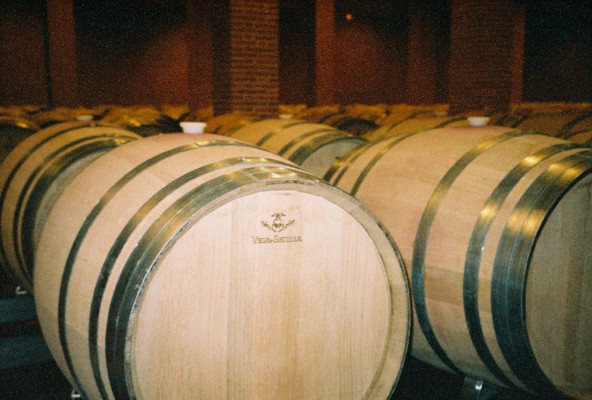 |
The cork testing regime is absolutely rigorous. Their cork suppliers are instructed to send samples: these are then sent to Excel, a specialist laboratory in France, where they are tested for mechanical and chemical soundness. If the tests are successful, an order is place. Upon delivery, a further double trial is carried out, with a sample of corks being sent away for testing. When corks fail, the whole batch is rejected, at the cost of the supplier, who also foots the bill for the laboratory testing. On average, Rafael Alonso believes that two out of every three corks are rejected. I find this very interesting, particularly taking into account the vertical tasting (see below) where of 81 bottles opened, none were corked. To my mind, it shows that if the cork industry took TCA seriously, they could do something about it. It would be interesting to know if other producers of prestige wines, such as the Bordeaux first growths, impose a similar regime on their cork suppliers.
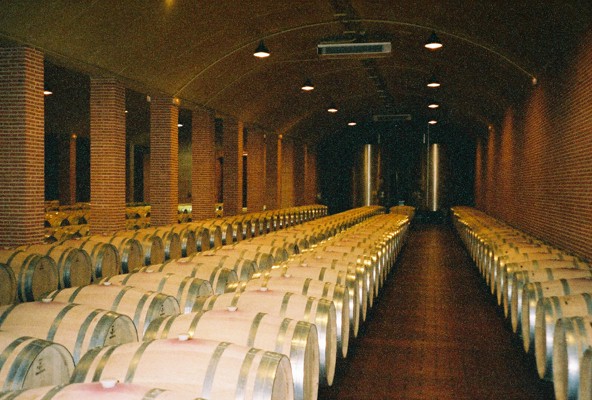
Both Valbuena and Unico spend several years maturing in oak before release, Valbuena for three and a half years, Unico for at least seven years. The wine is initially in large vats, then moves to new barrels, before being racked into successively older casks, on average every 10 months. Before bottling, the wine spends some more time in large vats to settle it. Vega Sicilia use a mix of French and American oak. The French barrels are used only once, the American ones will be re-used for about six or seven years. The French oak barrels are bought in, while American oak is imported and seasoned in the winery yard for at least two years, with a further year’s seasoning under cover, before being made into barrels in the estate’s own cooperage. The smell in the cooperage is amazing: a mixture of a carpentry shop and toasting oak, and a single taciturn cooper works diligently, resenting this intrusion.
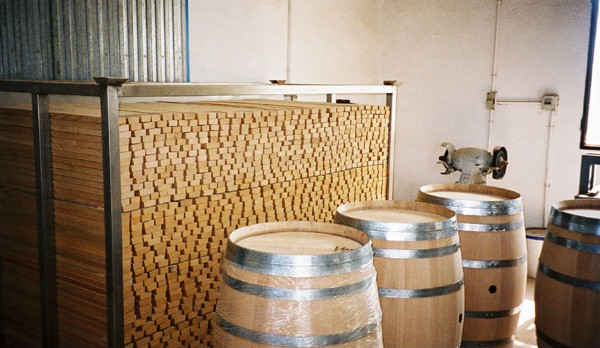
Prepared oak staves and newly completed barrels in Vega Sicilia’s cooperage.
(The nearest barrel is actually wrapped in plastic: it's not a trick of the
light or image compression)
Bottling is, of course as high-tech as it gets, and once in bottle, the wine is aged for a further period. The bottle store is the newest building on the estate, and continues the religious theme, this time harking back more to Greco-Roman temples.
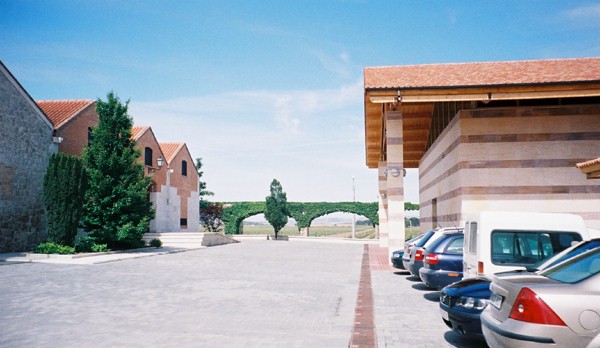
The bottle store, on the right beyond the cars
Valbuena will spend one and a half to two years in bottle before being released. The length of time that Unico is aged in bottle, on the other hand, depends on the format: single bottles have at least three years in bottle; magnums and double magnum rather longer. For example, just over 109,000 75cl bottles of the 1990 Unico were released in 2000 and 2001. Magnums of the 1990 Unico will be released in 2004, and the double magnums (all 150 of them) in 2005.
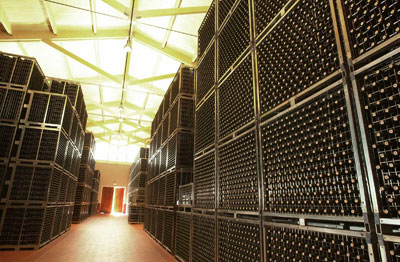
Go on then, work it out: at least £100 a bottle retail (2003 prices!) - what’s the value of the stock in this photograph? (photo from vega-sicilia.com, mine are just too dark) Note the use of stainless steel throughout and spotless conditions. The building is fully climate controlled, and while there are windows, the amount of light apparently entering the building in this photograph is deceptive.
After the appropriate level of oohing and ahhing at the bottle store, Rafael Alonso leads us to the chateau building, which is also the Alvarez house when they are in residence. Initially, unprepossessing close up, the interior is as elegant and sumptuous as you would expect. In a drawing room there is a sideboard with some museum pieces: bottles of Unico going back to the 1920s. A more recent magnum stands below a painting on the wall: magnums of Unico carry paintings on their labels, copies of ones which hang in this house.
We move into the dining room, where a large (15-20' diameter) round, highly polished table has a rather splendid array of glasses waiting for us, including the Riedel Unico glass, made especially for Vega Sicilia in 1995: it is similar to the Bordeaux glass, but bigger.
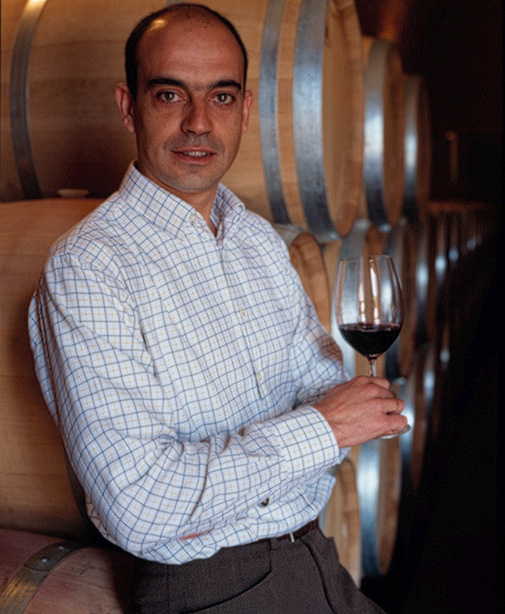
Xavier Ausas, winemaker
(photo from vega-sicilia.com)For the tasting, we are joined by Xavier Ausas, Vega Sicilia’s winemaker and now Technical Director. Xavier has worked for Vega Sicilia since 1989, was responsible for launching Alion, and took over full responsibility from Mariano Garcia, who left to spend more time on his own Mauro project. Two thoughts from Xavier Ausas:
"Vega Sicilia starts discretely and finishes hugely." and "The vine is a good mother: she will try to nourish however many bunches of grapes she produces, unlike other fruits which will always drop their excess fruit." Hence the emphasis he puts on green harvesting to keep crops down.
I was pleased to meet Xavier Ausas and Rafael Alonso again on 22nd November 2003 at the Decanter Fine Wine Encounter. They presented a masterclass tasting covering 6 decades of Vega Sicilia, with Jasper Morris of the UK importers Morris & Verdin providing the general background and acting as translator for Xavier Ausas, who only occasionally forgot that he couldn't speak English! The notes that follow combine the tasting held at Valbuena (indicated by V) and that masterclass (indicated by D).
For the masterclass, 9 bottles of each of the 9 wines, provided direct from the private cellars of the Alvarez family, had been opened and double decanted at around 1 p.m., two and a half hours before the masterclass started at 3.30 p.m. It was a brave decision to open such old wines so far in advance. It is a testament to Vega Sicilia’s rigorous cork selection and testing process that none of the 81 bottles was corked.
Oremus Dry Furmint 2001 Mandolas
Whole bunch pressing, fermented in Hungarian oak, then five months’ ageing in new Hungarian oak. A creamy nose with peaches and pears. Quite light initially, then fills with creamy stone fruit dominating the palate. Very pleasant wine, with a nice fragrant note. V
100% tempranillo with 13 months in 100% new French oak casks. Released after two years in bottle. A heavy, prestige bottle embossed with the winery name and crest.
Big nose with vanilla and some exotic fruit and a bit of marzipan. Very Bordeaux like in style. Huge tannic structure and also a good acidic backbone. Complex, with nice fruit and an excellent finish. V
This was the first vintage for which Xavier Ausas had full responsibility, having joined Vega Sicilia in 1989. It was a difficult harvest (though it does seem that most Vega Sicilia harvests are difficult!), following a lot of summer rain, saved only by some good weather at the end of the ripening season. As is usual at Vega, harvest began in October. The 1998 is the only year when they have used the stalks as well as the fruit, having included around 10%-15% stalks in the brew. 85% tinto fino (i.e. tempranillo), 15% merlot and malbec
A very dark appearance, with plenty of youth evident. Intense black plums on the nose, with a touch of licorice, and some balanced oaking. Nice fruit on the palate, but then massive, very massive tannins. The big meaty fruit still comes through though. A complex, if rather austere wine. D
Although 1999 was looking like a great year, it turned out to be another tough harvest, becoming increasingly renowned for the surge in Marlboro shares as Xavier Ausas chain-smoked himself through the harvest, the hardest he has known. Harvest began fairly normally on 10th October, but lasted only until 14th October when heavy rains put a stop to it. The rains continued until 26th October and harvesting recommenced at the start of November. In the meantime, all the harvesters remained on the payroll, employed on repeated checks on the vines, removing any grapes that displayed any sign of rot and trimming back foliage to keep a good airflow around the grapes that remained. 80% tinto fino, the rest mainly merlot with some malbec. This wine will be released in 2004.
The 1999 Valbuena has a lighter appearance, with more youth. On the nose, there is plummy black fruit, especially blackcurrants and an oaky sweetness. The nose is intense and long with great depths, and pleasantly aromatic. I find this quite different and a much lighter style of Valbuena. There is more forward fruit on the palate, neatly balanced by some acid. Still a lot of tannin, but it’s already softer and silkier than the 98. A very spicy finish concludes a wine that is showing remarkably well, but I wonder whether it has as much longer term potential as the 98 and particularly the 2000. The 1999 Valbuena was also tasted in May at Vega Sicilia: my notes are entirely consistent. D and V
Yet another difficult year, though this time the problems were during the growing season rather than at harvest. Two hard frosts at flowering set things off badly and things didn't improve. 45% - 50% of the crop was removed in a green harvest, with the result that yields were very low. I have a note here that says that in 2001 and 2002 the crop was even smaller, down to 6 litres per hectare: I guess that should be 6 hectolitres per hectare, but even that seems extraordinarily low. This wine was bottled in July 2003, and will go on sale in 2005. Back to 85% tempranillo.
This has the same apparent level of youth as the 1999, but is much darker and more opaque. The nose shows vanilla, tobacco and lots of dark plummy black fruit. On the palate the immediate impression is of plenty of forward fruit and lots of tannic structure. This is a complex wine, much more so than the 99, and while the 99 had a lighter style all round, the 2000 also has an impressive elegance. Big potential. I have to agree with Xavier Ausas that the 2000 combines the finesse of the 99 with the power of the 98. D
An even, black plum skin colour. Intense leather black fruit on the nose: very aromatic and even a touch portlike. Plenty of oak evident, but well balanced and not at all distracting. Excellent fruit on the palate with a spicy richness. Layer after layer. Great depth with good tannins. Amazing length. Clearly still rather young, but already well balanced. This will be released in 2004. D
Interesting mature colour. Fabulous nose - layers & layers. Lovely attack. Gosh I like this. Beautiful. Smooth, rich, interesting. Exceptionally good. (Tasted 5/10/02)
This is the current (2003) release of Unico, at least in bottles: the larger format bottlings have yet to be released. 80% tempranillo, 20% Cabernet Sauvignon. Two years in large oak vats; 16 months in a mix of US and French oak new barrels, 3 years in a mix of new and old barrels, three in used barrels and a final three years back in large oak vats.
Slightly more mature than the 1991, but hardly noticeable. Even and dark. A very complex leathery, brambly nose with a certain gaminess and a blackcurrant-chocolately sweetness. Nice use of oak. Very elegant. Light fruit initially complemented by excellent tannins and building in the mouth. Very well balanced and really well integrated. D
Fabulous nose. Soft subtle hedgerow fruits with leathery notes, a roast pork meaty smokiness and a touch of spirit. Some fruit initially. Nice elegant structure. Very fine and elegant despite its evident youth. Good tannic structure and excellent balance. Has decades ahead of it. V
A difficult harvest, much interrupted by rain, and consequently a small release. 80% tempranillo, 10% Cabernet Sauvignon, 10% Merlot.
Excellent colour. Bright and clear appearance, just starting to mature. More blackcurrants on the nose, although the percentage of Cabernet in the blend has gone down. Bit of a thumper. Dark, leathery fruit with hints of cocoa bean. In the mouth, this is big and integrated, full and round. Huge depth and complexity with loads of layers and also huge elegance. Very attractive indeed. Excellent drinking. D
Rather oddly, nothing from the 1970s, and so we leaped back to my birth year.
A mere 65% tempranillo, with 20% cabernet sauvignon and the remaining 15% coming from a mixture of merlot, malbec and albillo. The last is a white grape, more commonly found in Toro, but often making an appearance in Unico, but usually only making up only about 1% of the total blend.
A very light mature colour, like 20 year old tawny port. Lovely nose. Very enticing and attractive. Gorgeous layered fruit. Touch of oxidation, though I don't find it unpleasant. Soft evolved fruit on the palate, with little or no reduction. Still a big wine, with lots of structure and huge length. Remarkable, though starting to show its age at the edges. I wonder if it's the lower percentage of tempranillo/tinto fino in this that makes it seem more advanced than its two older sisters, the 1953 and the 1942? D
80% tempranillo, 15% cabernet sauvignon. Coo! A superb mature colour, still with nice depth (more so than the 64). Slight bricking. Very aromatic on the nose with a cedary nuttiness, but still some pretty big fruit showing through. Superb. Elegant. Velvety. So much fruit! Remarkable, nay incredible. D
My empty bottle says a mere 12,000 bottles made. 75% tempranillo, 15% cabernet sauvignon.
Of course it looks fully mature, with an orangey rim, but it's certainly not overly brickish. Some volatile acidity on the nose and I suppose naturally enough a bit of oxidation, but rather interesting with some complex depths and a touch port-like. On the palate, it's difficult to believe this is 61 years old: there is so much life and vitality and there's still plenty of red fruit in there. Soft buttery tannins with a sweetness of fruit to it. I found a touch of spirit on the finish. D
Oremus Late Harvest Furmint 1999 (half bottles)
Fermented in stainless steel and aged for months in new oak. 102 g/l residual sugar. Amazing nose: some honey and some very fresh tropical fruit. Very good attack. Very fine balance of sweetness and acidity. Creamy rich, exceptionally fine and elegant. V
Oremus Late Harvest Furmint 1998(half bottles)
Rich coppery gold. Intense nose - honeyed, slightly raisined tropical fruit and citrus. Elegant and rich. Very good mouthfeel. Attractive sweetness that avoids being cloying. Intense, very fresh fruit flavours with very good length. Very good indeed, though it's not quite as good as the 1999. The 1998 had, apparently, suffered from a lot of rain throughout the year, while 1999 was a much better year.
Oremus 5 puttonyos Tokaji Aszu 1995 (50cl)
Fermented for 40 days in stainless steel then 3 years in Hungarian oak casks. 136 g/l residual sugar.
Exceptionally elegant nose: quite restrained. A honeyed sweetness. Very full. Just enough acid to keep it fresh. Very exotic flavours with a strong dried apricot backbone. Hedonistic. V
So what’s the reality of the myth and legend of Vega Sicilia? The usual story: a long history, some very long-lived wines, restricted production, a touch of marketing spin and a huge attention to detail in the winery. "Myth and legend" is going over the top, but I have no doubt that this is one of the top wine producers in the world and with their continuing interest in new ventures like Oremus, Alion and especially Alquiriz, they deserve our attention.
Text and images © A J Stevenson 2003, except where photographs are indicated to be taken from vega-sicilia.com
Back to Andrew Stevenson's web page
Last updated: 19 October 2006 12:09